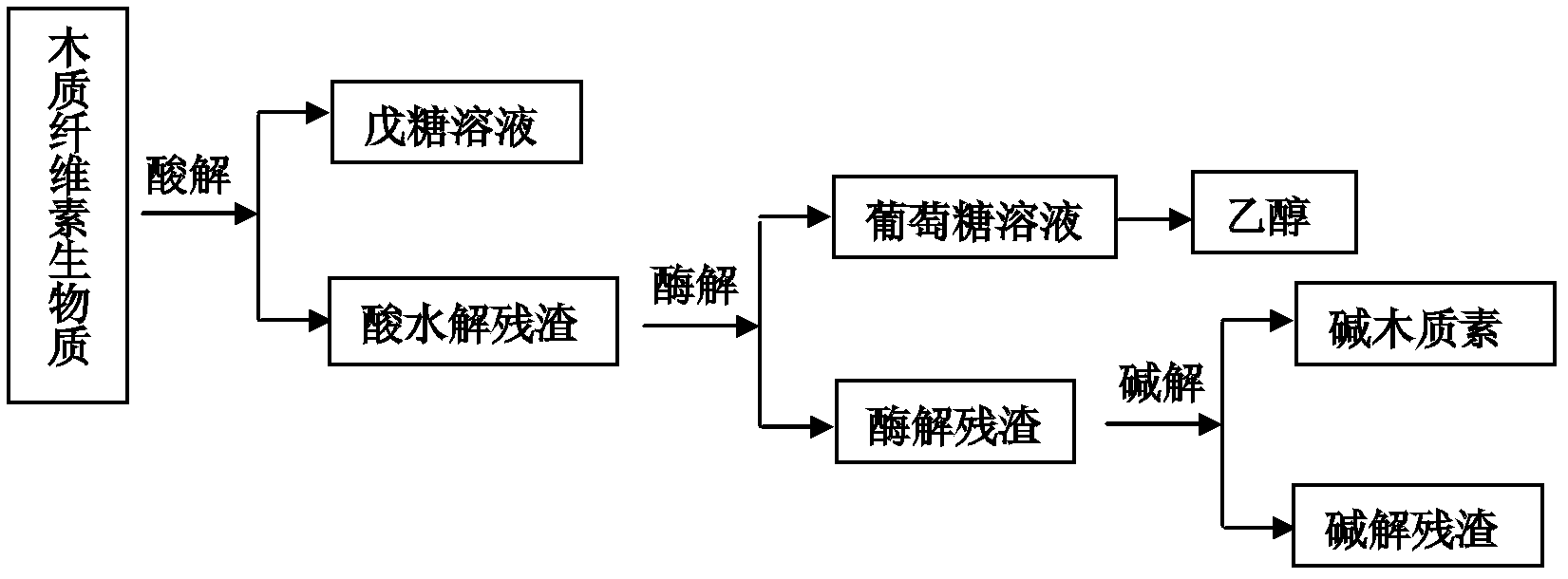Comprehensive utilization method of lignocellulose biomass
A lignocellulose and biomass technology, which is applied in the field of comprehensive utilization of cellulose, hemicellulose and lignin in lignocellulosic biomass, can solve problems such as low conversion rate of cellulose enzymatic hydrolysis, improve extraction rate, simplify Production process, the effect of reducing dosage
- Summary
- Abstract
- Description
- Claims
- Application Information
AI Technical Summary
Problems solved by technology
Method used
Image
Examples
Embodiment 1
[0048] (1) acid hydrolysis
[0049] 10.6kg corn cobs (mass composition: moisture 6.12%, cellulose 35.19%, hemicellulose 32.1%, lignin 23.7%, other 2.95%, the same below) are broken, washed with water to remove dust, and then processed with 80kg phosphoric acid solution Hydrolysis, the mass concentration of phosphoric acid solution is 15%, the temperature of acid hydrolysis is 140 ℃, the time is 0.5 hour, the acid hydrolysis residue and the pentose sugar solution obtained after hydrolysis are separated, wash described acid hydrolysis residue with 10kg water, cleaning solution Merge with described pentose solution, finally obtain 17.9kg acid hydrolysis residue (moisture content is about 65%, the absolute dry content of hemicellulose is 13.03%, the absolute dry content of lignin is 32.67%, the absolute dry content of cellulose 49.27%) and 82.07kg pentose solution, the concentration of pentose solution is 3.16%, and the extraction rate of hemicellulose is 76%.
[0050] The calcul...
Embodiment 2
[0062] (1) acid hydrolysis
[0063] Break 10.6kg of corncobs, wash with water to remove dust, and then hydrolyze with 80kg of phosphoric acid solution, the mass concentration of phosphoric acid solution is 20%, the temperature of acid hydrolysis is 100°C, and the time is 2 hours. After the hydrolysis is completed, the separated acid hydrolysis Residue and pentose solution, wash described acid hydrolysis residue with 10kg water, and cleaning solution merges with described pentose solution, finally obtain 16.42kg acid hydrolysis residue (moisture content is about 65%, and the absolute dry content of hemicellulose is 11.86 %, the dry content of lignin is 32.72%, the dry content of cellulose is 49.95%) and 83.56kg pentose solution, the concentration of pentose solution is 3.26%, and the extraction rate of hemicellulose is 80%.
[0064] (2) Enzymatic hydrolysis of cellulose
[0065] Take the acid hydrolysis residue described in step (1) as the fiber substrate, and carry out cellul...
Embodiment 3
[0069] (1) acid hydrolysis
[0070] Break 10.6kg of corncobs, wash with water to remove dust, and then use 80kg of phosphoric acid solution for hydrolysis, the mass concentration of phosphoric acid solution is 5%, the temperature of acid hydrolysis is 150 ° C, and the time is 3 hours. Residue and pentose solution, clean described acid hydrolysis residue with 10kg water, and cleaning solution merges with described pentose solution, finally obtains 18.01kg acid hydrolysis residue (water content is about 65%, and the dry content of hemicellulose is 13.52 %, the absolute dry content of lignin is 32.49%, the absolute dry content of cellulose is 49%) and 81.98kg pentose sugar solution, the concentration of pentose sugar solution is 3.12%, and the extraction rate of hemicellulose is 75%.
[0071] (2) Enzymatic hydrolysis of cellulose
[0072] Take the acid hydrolysis residue described in step (1) as the fiber substrate, and carry out cellulose enzymolysis, the condition of the enzym...
PUM
 Login to View More
Login to View More Abstract
Description
Claims
Application Information
 Login to View More
Login to View More - R&D
- Intellectual Property
- Life Sciences
- Materials
- Tech Scout
- Unparalleled Data Quality
- Higher Quality Content
- 60% Fewer Hallucinations
Browse by: Latest US Patents, China's latest patents, Technical Efficacy Thesaurus, Application Domain, Technology Topic, Popular Technical Reports.
© 2025 PatSnap. All rights reserved.Legal|Privacy policy|Modern Slavery Act Transparency Statement|Sitemap|About US| Contact US: help@patsnap.com

